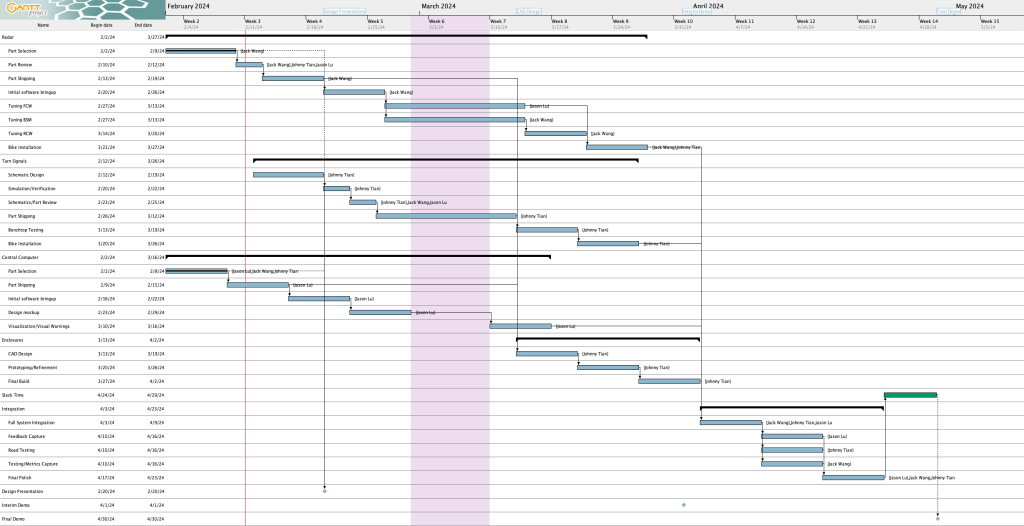Personal Progress
- Worked on the design review slides along with my team
- I developed a block diagram for our system:
- Since we were planning to use a power bank, I wanted to to figure out if USB negotiation is needed for higher power. Decision: No need for negotiation, see power allocation
- I looked at https://electronics.stackexchange.com/questions/511559/type-c-non-negotiated-power-and-20v-protection which states that 1A will be available from VBUS and GND by default.
- However, this Sparkfun USB-C breakout allows 1.5 A up to 3 A. After reading the schematic for that and the USB-C datasheet, I found out that breakout board has resistors that allow for a higher current
- From the K-LD7 datasheet, we know that the K-LD7 draws up to 200 mA peak (so 400 mA total for two radars)
- Each LED light draws 0.2 A (1 W at 5V)
- Although we may need more lights? https://www.hidnation.com/blogs/news/how-many-lumens-in-a-car-headlight suggests typical car lights are 700 lumens and our LEDs are only 200 lumens
- The screen draws less than 0.62 A (the 7″ version draws 0.62A so a smaller screen should draw less current)
- The good news from https://pinout.xyz/pinout/pin2_5v_power/ is that the 5V pins provide current from the power supply which is 3A
- The RPi 4 in one test peaked at 0.885 A when loading the desktop which seems like a reasonable approximation for heavy load
- Therefore, the following power allocation should work:
- RPi (3A total):
- 2x radars – 0.4 A
- Screen – 0.62 A (USB port is 1.2 A max)
- RPi itself – 0.885 A
- Total: 1.905 A < 3 A
- Other USB port (1A total):
- 0.4 A minimum for two lights
- RPi (3A total):
- I looked at https://electronics.stackexchange.com/questions/511559/type-c-non-negotiated-power-and-20v-protection which states that 1A will be available from VBUS and GND by default.
- Researched how to connect multiple wires together (without a PCB or breadboard) since we plan to directly wire the battery pack to the radars, lights, and potentiometer circuit. Decision: Go with wire nuts
- My original idea was to solder things, but I got spooked by this Reddit post which talked about solder melting, although in hindsight it was talking about code compliance which doesn’t apply to us and house wiring (we won’t be pulling that much current)
- https://diy.stackexchange.com/questions/135925/when-to-use-electrical-tape-rather-than-wire-nuts rules out electrical tape because they say electrical tape does not hold things together which we need
- Then I remembered that at work I’ve used wire nuts before, so I wondered about using wire nuts to tie them all together (I forgot that they were called that so I had to Google “twist on wire connectors” lol)
- https://diy.stackexchange.com/questions/123930/wire-nut-several-wires-together implies that it is possible to use wire nuts on multiple wires, except there are limits to how many wires you can stuff into one
- Another Stack Exchange answer and this post (see step 3 photo) indicated that wire nuts are a valid way to connect things together
- Other sources suggested using terminal blocks/strips (where strips are multiple blocks combined) or butt splices, but I either couldn’t verify that they would work since I’ve never used them (like this WAGO connector), looked to be expensive from a first search on Digikey although later sorting showed < $12 ones (although $12 is pretty expensive still compared to wire nuts), or I didn’t want to deal with trying to bridge together the terminals with jumpers/special pieces of metal as the answers suggested
- https://diy.stackexchange.com/questions/123930/wire-nut-several-wires-together implies that it is possible to use wire nuts on multiple wires, except there are limits to how many wires you can stuff into one
Schedule
Out of the 4 deliverables from last week, I only met one (green = completed, red = incomplete). However, I’m still on schedule as I have until 02/21 to complete initial software bringup and I plan to test the Pi and start software bringup this week.
- Get the RPi up and running
- Select a graphical framework
- Write a barebones hello world GUI application
- Select and order a display to attach to the RPi (done with team)
Deliverables
Here are the deliverables for this week:
- Complete the design review slides
- Get the RPi up and running
- Select a graphical framework
- Write a barebones hello world GUI application
- Begin UI mockup

